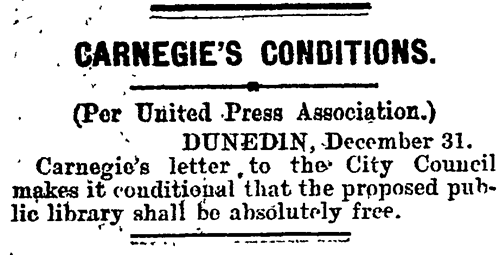
Carnegie's conditions announced in 1903 newspaper.
Carnegie’s ‘free’ libraries
In the early 20th century a number of New Zealand communities established ‘free’ libraries with the assistance of a Scottish-born American businessman and philanthropist, Andrew Carnegie. As elsewhere in the country many of these communities already had libraries, often set up by mechanics' institutes, literary societies or athenaeums. But access to these institutions was generally restricted to those who could afford to pay a subscription, whilst Carnegie's libraries were intended to be ‘absolutely free’. In practice this proved to be a lofty ideal which many communities struggled to meet, and others simply chose to ignore.
The first Carnegie libraries were built in communities in which Andrew Carnegie had a personal interest, such as in his home town of Dunfermline, Scotland, in 1883. But as his fortune burgeoned from the late 1890s he extended his library-giving programme at home and abroad. In total he and the Carnegie Corporation of New York which he endowed were responsible for the erection of 2509 libraries in the United States, Britain and Ireland, Canada, Australia, the Caribbean, Fiji and New Zealand. New Zealand fared well compared to its Tasman neighbour, with 18 libraries to Australia's four.
Under the 1869 Public Library Act local councils in New Zealand were able to charge a penny in the pound rate to support a public library on the condition that it was free (and could qualify for a government subsidy). Many also already had a supply of books, or could arrange to take over the collections of local mechanics' institutes, literary societies or athenaeums. But the capital cost of a erecting a building continued to be a barrier. For many councils Carnegie offered the perfect solution - at least at first glance. Most were able to comply with the condition that they provide a debt-free site for the library, and that they commit an annual sum to support it (for which the penny in the pound rate could be used). But another condition, one of the basic tenets behind Carnegie's grants - that the library should be free - proved contentious.
The problem was that most councils interpreted 'free' differently to Carnegie. They believed it meant the provision of a free reading room and applied for the grant on this basis. It was only when councils followed up with Carnegie that they learnt that he meant the libraries to be ‘absolutely free' - with no charges, even for borrowing. Councils had real difficulty with this because the penny in the pound rate was not sufficient to allow for free borrowing and they were reluctant to put too heavy a burden on ratepayers. On learning of Carnegie's interpretation some councils, such as Nelson and Wanganui, withdrew their applications or declined the grant. Others, such as Dunedin and Timaru, accepted the grant but struggled to provide a free lending service on the allowable rate.
Failed applications
Seven of the 25 applications to Carnegie from New Zealand were turned down; among them was one from the Auckland borough of Parnell. Carnegie's private secretary suggested that Parnell come up with ‘less elaborate plans’ - a suitable building should be able to be erected for ‘just half the sum’ they had requested.
Other councils accepted the grant without seeking clarification from Carnegie and believed, or at least pretended to believe, that by providing a free reading room they were abiding by his conditions. At least one library, Hastings, was called to account by Carnegie after a local resident wrote to him to complain about the charges. They appear to have subsequently dropped these charges for a time before reintroducing them, only to be caught out again after the library building was destroyed in the 1931 Hawke's Bay earthquake. The council applied to the Carnegie Corporation of New York (which Carnegie had endowed in 1911) for funds to rebuild the library. The Corporation declined, noting that they had not abided by the conditions of the original grant.
The last Carnegie library in New Zealand opened in Marton in 1916. That year Carnegie received a critical report from Dr Alvin Johnson, who had concluded after visiting 100 Carnegie libraries that the money would be better invested in supporting the training of library personnel. The Corporation stopped issuing new grants for the building of libraries from 1917 and, following Carnegie's death in August 1919, the focus of its library programme shifted to improving quality. In New Zealand this took the form of supporting librarians to study in the United States and Europe, particularly during the 1930s and 40s, and undertaking surveys into the state of the library service, notably the Munn Barr report of 1934.
Further information
Links
- Carnegie libraries in New Zealand (Te Ara)
Publications
- ‘Six lost, twelve remain', New Zealand Historic Places, No 60, September 1996, pp. 22-23.
- Kerry Rodgers, ‘Carnegie's Legacy', New Zealand Geographic, No 76, November-December 2005, pp. 52-67.


Community contributions